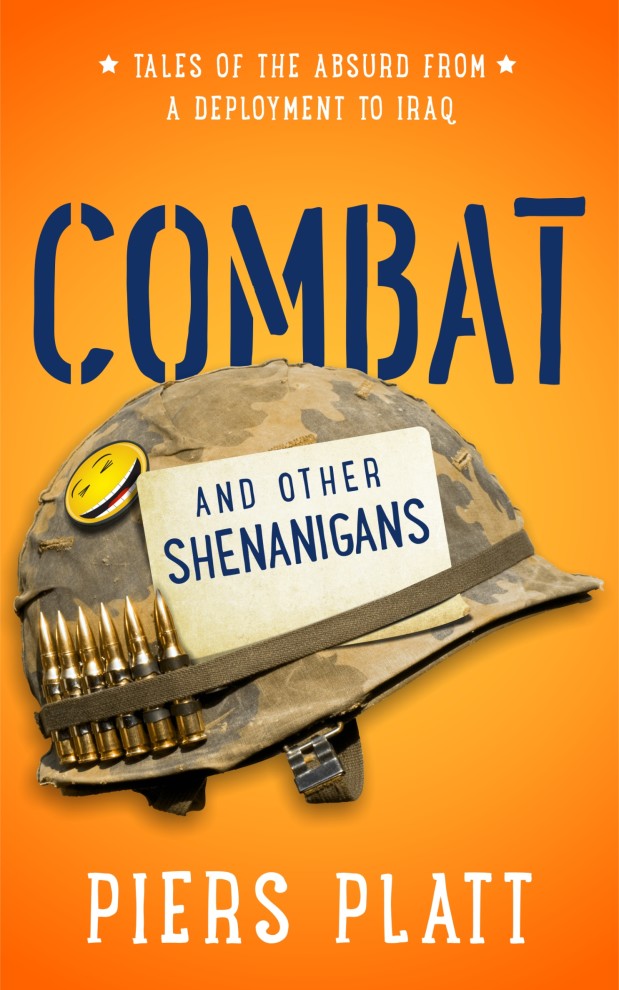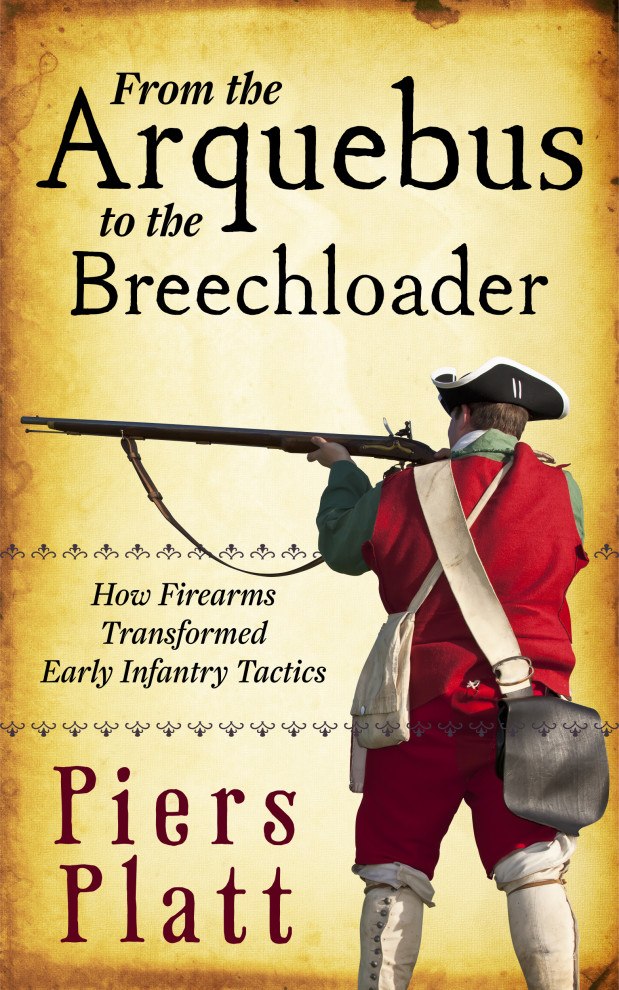From the Arquebus to the Breechloader – Excerpt
Though horse-mounted knights had dominated warfare in the Middle Ages with their shock-based assault tactics, the role of the infantry had been steadily on the rise by the 14th century. In battles like Crecy and Agincourt, “Swiss pikemen and English archers suddenly and dramatically enhanced [infantry’s] role.” The introduction of gunpowder only hastened this shift in battlefield focus, and though “the invention of gunpowder took a long time to affect land warfare,” the changes that firearms wrought would be profound.
The exact origins of gunpowder are unknown, but it is fairly certain that the compound (made from saltpeter, sulphur, and charcoal) was first developed in China, though sources differ as to when it first appeared: “perhaps as early as the ninth century AD” or “about the 11th century AD.” Regardless of the date of its origin, gunpowder made its way west to the European continent, and the first European bombard weapon, which used gunpowder to propel an arrow out of a large metal cask, can be traced to the year 1326. Though the combustible “Greek fire” had been in use as a type of incendiary projectile for centuries by the Byzantines and Muslims, the bombard was the first example of a combustible material used to fire an object at a target:
“To reverse the process and use combustion itself as a propellant of missiles was a more difficult and dangerous affair, demanding among other things an expertise in metal casting which was developed in the West, ironically enough, to serve that most peaceful of purposes, bell founding. From bells to bombards was an all too easy step.”
Gunpowder’s use on the battlefield was mainly restricted to that of a siege weapon, the massive metal bombards (and later, cannons which fired actual stone or metal shot) being too heavy to move effectively in open warfare. But it was not long before European innovators thought to place the power of these artillery pieces in the hands of an individual infantryman: “the first known reference to special hand-held fire-arms in Europe dates to 1364,” roughly 40 years after gunpowder appeared on the field of battle. The earliest innovators of handheld firearms showed a degree of bravery bordering on folly, however, due to the unstable nature of the weapons they tested: “using [gunpowder] even in a primitive cannon must have demanded remarkable courage from a daring individual, all the more so if we realize that early cannon often burst from shock…a missile-throwing weapon held in the hands required, therefore, the passage of a high threshold of mistrust, anxiety, and outright fear.” Realizing the high potential of firearms, however, Europeans overcame their fears, and firearms were in general use by 1550.
The earliest handheld firearms were little more than a miniaturized bombard or cannon, a long metal tube with a touchhole on top to which a red-hot needle or coal could be applied to spark the powder within. Such a primitive system was rife with difficulties, not the least of which was the inability of the wielder to aim the weapon: “to hold the gun in one hand and touch the match to the hole with the other made aiming virtually impossible.” These early firearms faced stiff competition from weapons which had already established their reputation on the battlefield, especially the longbow and the crossbow: “lacking greater power and with a slow rate of fire, the handgun could not compete with the precision of the crossbow, the high rate of fire of the bow, or the accuracy of either.” Firearms also faced opposition from conservative nobles, who recognized that, despite its flaws, the handgun gave commoners the ability to level the playing field which had been so thoroughly dominated by the mounted knight: “armed with a crossbow a man might…[kill a knight] from a distance without putting himself in danger. What was true of the crossbowman was even more true for the handgunner.” But despite protests from the elite warrior class and competition from older weapons, technological improvements made the use of firearms even more widespread, with dramatic effects: “the spread of mass-produced firearms, however, swiftly transformed the nature of warfare in the West.” Indeed, beyond their effects on the conduct of battle, firearms, with their high degree of effectiveness against castles and armor alike, helped bring about the end of the feudal system in Europe: “gunpowder weapons are said to have ended the age of armor.”
Arquebus, Matchlock, and Pike
The handgun was refined during the 15th century by four major technological improvements: the addition of a curved stock (giving rise to the term “hooked gun” or arquebus, in French) to enable the firer to brace the weapon against his shoulder and take aim along the barrel, the refinement of gunpowder through the process known as “corning,” the addition of a priming pan, and the invention of a device called the matchlock. Wooden stocks had been added to handguns from their earliest inception, but mainly as a means of being able to hold the barrel after it had become too hot to touch from firing. The invention of the matchlock allowed the addition of a stock that not only braced and steadied the weapon during firing, but also enabled the firer to sight along the barrel and thereby increase the weapon’s accuracy. Early versions of gunpowder neglected to maximize the compound’s explosive capabilities because “lack of sufficient airspace between the fine powder particles retarded the explosion…by providing equal distribution of airspace, corned powder made explosion more uniform and instantaneous.” This meant that less powder could be used with greater effect, making guns more efficient while simultaneously increasing their range and muzzle velocity. The addition of a priming pan was accompanied by a relocation of the touchhole, which was moved to the right side of the barrel, and which increased the reliability of early firearms. The priming pan, located next to the touchhole, allowed the arquebusier to “prime” the weapon by pouring a small amount of powder into and around the touchhole, thereby increasing the likelihood that the weapon would fire when called upon to do so.
The matchlock itself, however, proved to be the most important and effective improvement made in firearms; indeed, without it, the addition of a priming pan would not have been possible:
“The most important development was the introduction of a glowing “match” and a device for holding it. The match was a cord or tightly twisted rag that had been soaked in saltpeter and then dried out. This would smolder…and would ignite priming powder sprinkled in the pan. The earliest device for holding the match was a simple pivoting serpentine to be lowered and raised by hand, but this was soon connected with a trigger, to become the matchlock.”
The fact that the matchlock remained the standard firearm of European armies for the next century shows just how revolutionary of an innovation it was, being the first “truly usable small-arms gunpowder weapon.” Despite this eminent utility, however, the arquebus matchlock, like its predecessor, faced competition with the crossbow for widespread acceptance in European armies. Unlike its predecessor the handgun, and owing mainly to its comparative cheapness, “with power equal to or greater than the crossbow and with about the same rate of fire, the arquebus began to supplant the crossbow by the end of the fifteenth century.” The arquebus was not only faster, cheaper, and easier to manufacture than the crossbow, it also “took far less time to train men to fire and arquebus than to pull a bow, so that far more infantry could be mobilized.”
But although the arquebus replaced the crossbow and longbow of medieval armies in the 15th century, it did so without dramatically revolutionizing the role of the infantry, largely because its low degree of firepower did not “[add] much to the effectiveness of soldiers armed with missile weapons.” The result was that cavalry continued to be the decisive arm in land warfare: “while artillery and, in particular, portable firearms were being used on an increasing scale, their rate of fire was still slow. The battles of Charles the Bold…all testify to the practical use of cavalry…a fifteenth century army was unlikely to achieve a decisive victory on the field of battle without it.” The continuing dominance of heavy cavalry on the battlefield forced the arquebusiers – who were unable to defend themselves against a cavalry charge with their slow rate of fire – to be dependent on pikemen for defense against cavalry. By forming a tight square (based on the Macedonian phalanx) with pikes facing in all directions, the pikemen were able to resist any cavalry attack, and thus defend the gunners, whose fire amplified the square’s defensive capabilities: “the square of pikemen provided the only place of safety where the light infantry might take refuge from the enemy’s heavy cavalry.”
But just having two types of infantry (pikemen and arquebusiers), and trying to manage a successful cooperation between them caused problems of its own in terms of tactics: “pikemen and musketeers could not simultaneously occupy the same space, and, while their weapons complemented each other, they could not do the same work. The battles of the Thirty Years’ War (1618-48)…were in consequence confused and messy affairs.”Though commanders tried intermingling the two types of infantry, “formations which allowed individuals armed with one weapon to move back and forth through those armed with the other…were found to be too loose and too easily reduced to chaos in battle.” While tactical experimentation demonstrated that the two different types of infantry worked best when combined in small groups, the strict details of how best to arrange those groups of pikemen and musketeers were yet to be determined.
If you enjoyed this sample, you can buy the full book by clicking here.












